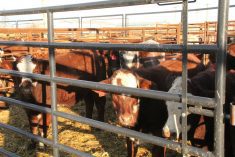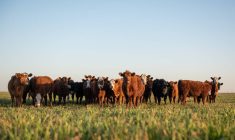The fear of bloat costs the livestock industry more than the condition ever does, says a well-known grazing consultant and researcher from Idaho.
“I’ve seen the figures from the States, and something like two one-hundredths of one per cent of the total cattle herd dies each year from bloat,” Jim Gerrish told attendees at a recent Foothills Forage and Grazing Association tour.
“Yet we restrict the diet of a whole bunch of animals from containing some very nutritious plants because of that fear of bloat.”
As the use of legumes such as alfalfa and sweet clover has increased in forage systems, so too have incidences of bloat, which despite the low mortality rate still ranks as one of the leading causes of death in adult cattle. But like many conditions, “there has to be a genetic susceptibility,” said Gerrish.

“There are herds that are completely resistant to bloat,” he said. “You have 100 cows and put them out on a pasture, and two of them bloat and die. Ninety-eight per cent of them, nothing happens. That says there’s something different about those 98 animals.”
And bloat is a “self-culling trait.”
“You don’t have to really work to cull bloat out of your herd,” he said. “You put them out on the alfalfa, it will cull itself out.”
But producers have to have “deep pockets” if they plan to take that route.
“If you have a herd that has high susceptibility to bloat, that’s a pretty substantial financial hit if more than one or two per cent die. And sometimes that happens.”
Read Also

Pig transport stress costs pork sector
Popular livestock trailer designs also increase pig stress during transportation, hitting at meat quality, animal welfare and farm profit, Agriculture and Agri-Food Canada researcher says
Mixing bloat-causing legumes like alfalfa with non-bloating ones — such as cicer milk vetch, sainfoin, and trefoil — is another route.
“If you have a mixture of bloating legumes and non-bloating legumes and the animals graze them together, the release (of tannins) from the non-bloating legumes in the rumen will suppress bloating from the alfalfa that they’re eating,” he said.
“That’s one of the advantages of doing a mixture of legumes.”
But in areas where other legumes aren’t as abundant, focusing on genetics may be a producer’s best bet.
“In the long term, if you are in an environment where alfalfa is the most reliable legume and it’s the one you’re most likely going to use, it is probably in your best interest to start selecting for bloat tolerance in your herd.”
Bloat management
But selection only works when producers know the history of the cattle in their herds, said Gerrish.
“If you’re doing stock and they’re coming in from sale barns from who knows where, and you know nothing about their background, then you really need to be on your toes about bloat management,” he said.
In those instances, products that contain poloxalene — the main chemical in bloat guards — can be worth the cost.
“A lot of people complain about the mineral and say it’s too expensive to feed,” said Gerrish. “Well, you don’t have to feed it the entire time they’re on this property.”
Gerrish suggests feeding a bloat guard five days prior to moving into any pasture with high alfalfa content and then feeding it as the cattle graze through the area.
“As soon as we’re off that alfalfa, we go back to feeding either no mineral or feeding a lower-cost mineral,” he said.
“If you’re grazing alfalfa steadily for 120 days, then yeah, you’re going to have that higher cost associated with it. But it doesn’t take too many dead animals to pay for quite a bit of bloat guard mineral.”
He steers clear of the bloat blocks, though, preferring to use loose mineral products instead.
“You can have bloat blocks in the field and still have animals die from bloat. They never lick on a block, so they don’t get the treatment,” said Gerrish.
“When we have used the loose mineral with poloxalene, the success rate of preventing bloat has been much, much higher.”
Some ranchers, he said, use laundry soap as a cheaper alternative to other chemicals, since poloxalene is a detergent.
“It’s bizarre — you get in a bar and there’s cowboys there arguing about the relative merits of Tide versus Cheer,” said Gerrish.
“There are people who do that on a regular basis and swear that it absolutely ended their bloat problem.”




















